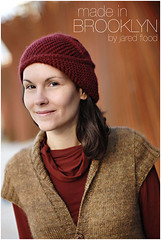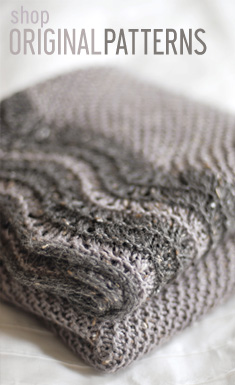4.09.2008
Anatomy of a Handspun: Part I
I recently heard someone say that spinning is a natural progression for any knitter. While I can't speak for everyone, I can say that when I think about how much I've learned about yarn since becoming a spinner, this statement definitely holds true for me. When you begin constructing and knitting with your own yarns, you're bound to reach a new understanding of what this fiber thing is all about, and that's a good day for everyone.
I received a lot of e-mail responses to my last post regarding the process of converting fiber to yarn. Lots of you want pictures! Do I detect many knitters on the brink of making a crossover? (Just remember, spindles are a cheap way to test the waters)(without causing marital problems) The art of spinning is something I am unqualified to present to you on any formal level, but I thought I'd do what I could and give you a visual journey through my own spinning process. This topic will span 2 to 3 posts, not only because I am wary of overwhelming non-spinners with too much foreign information, but because currently my personal spinning time is a rarity, and this current spinning project is literally in progress. I think it works best this way for all of us. Now, shall we begin?
Wool comes to handspinners in many different forms. In our case we'll be looking at hand-dyed roving, which seems to me one of the more popular ways urban spinners (with no space for cleaning or carding fleeces) like to roll.
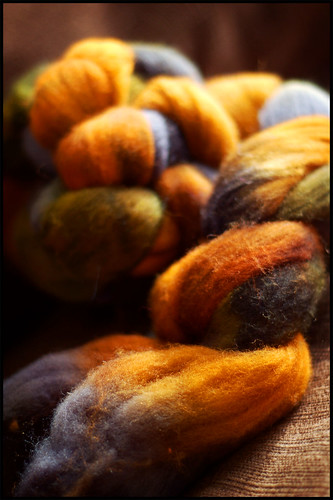
A roving is a continuous strip of combed or carded fibers to which a slight twist has been added (to keep everything everything together for dying, shipping, etc). Basically, a long, doughy strip of compressed wool. Rovings often come in braids after they've been dyed, like the one shown above. This particular beauty comes to us from the good folks at Interlacements in Colorado.
Unfurl the braid to see the roving in its entirety. The photo below shows the roving unbraided and reveals the dying scheme - spacial color fields of oranges, blues, and greens. Purdy, ain't it?
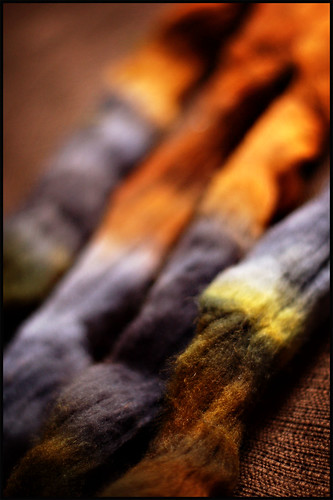
Roving is too dense to spin as-is and must be drafted first. Some spinners draft as they spin, others, like me, prefer pre-drafting. Drafting is essentially drawing the fibers out gently from one another to allow air into the spaces between individual fibers. When wool is drafted well it flows easily and consistently while spinning, which is desirable if you like your yarn nice and even. Notice below the difference in the fiber between my fingers and those that have yet to be drawn out. Wispy!

In the wrong mindset, drafting can be an annoying precursor to the good stuff, although I tend to enjoy it - preparing the fiber and getting to know the tactile qualities of your specific batch of wool adds a special layer to the process. Kind of like giving your fiber a massage.
Depending on what color-effects you're after, you may choose to tear the roving into strips and draft them individually. By doing this you essentially reduce the length of color repeats in your yarn - a quality you can manipulate in order to conjure up self-striping color patterns or other color tricks in your final yarn. With a well-dyed roving, you have a whole lot of possibilities - no two yarns will ever be exactly the same.
Below is a strip of roving (this time around, I split mine into 4) balled up on the window before being drafted.
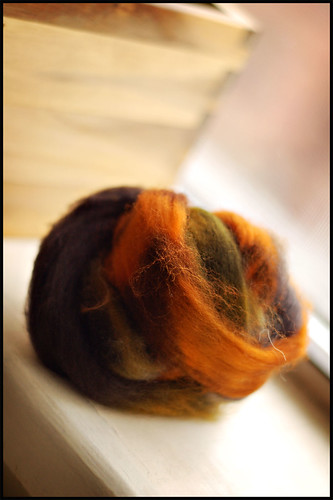
Drafting magically makes your fiber amount seem to multiply exponentially - what used to slink easily into the bottom of your basket as a tidy little roving now gently floats up over the edges - a sumptuous cloud of colorful wool bursting with potential, just waiting for a romp with your wheel. A rather delicate thing of beauty in itself (Note: not pet friendly, nor wind friendly for that matter).
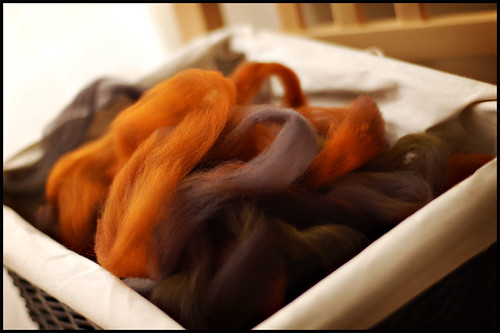
A nice big basket of pre-drafted fiber is a great thing to have around (see above if you own pets) - beautiful on its own, but always ready for a quick spin. And with this full basket, we conclude this evening's portion of our tour - fiber prep.
Up next we get down-n-dirty making yarn, followed by some form of knitting-with-handspun, although I'm not promising any projects... if I did, I may never get around to that third post! Stay tuned for more spinning fun!
I received a lot of e-mail responses to my last post regarding the process of converting fiber to yarn. Lots of you want pictures! Do I detect many knitters on the brink of making a crossover? (Just remember, spindles are a cheap way to test the waters)(without causing marital problems) The art of spinning is something I am unqualified to present to you on any formal level, but I thought I'd do what I could and give you a visual journey through my own spinning process. This topic will span 2 to 3 posts, not only because I am wary of overwhelming non-spinners with too much foreign information, but because currently my personal spinning time is a rarity, and this current spinning project is literally in progress. I think it works best this way for all of us. Now, shall we begin?
Wool comes to handspinners in many different forms. In our case we'll be looking at hand-dyed roving, which seems to me one of the more popular ways urban spinners (with no space for cleaning or carding fleeces) like to roll.

A roving is a continuous strip of combed or carded fibers to which a slight twist has been added (to keep everything everything together for dying, shipping, etc). Basically, a long, doughy strip of compressed wool. Rovings often come in braids after they've been dyed, like the one shown above. This particular beauty comes to us from the good folks at Interlacements in Colorado.
Unfurl the braid to see the roving in its entirety. The photo below shows the roving unbraided and reveals the dying scheme - spacial color fields of oranges, blues, and greens. Purdy, ain't it?

Roving is too dense to spin as-is and must be drafted first. Some spinners draft as they spin, others, like me, prefer pre-drafting. Drafting is essentially drawing the fibers out gently from one another to allow air into the spaces between individual fibers. When wool is drafted well it flows easily and consistently while spinning, which is desirable if you like your yarn nice and even. Notice below the difference in the fiber between my fingers and those that have yet to be drawn out. Wispy!

In the wrong mindset, drafting can be an annoying precursor to the good stuff, although I tend to enjoy it - preparing the fiber and getting to know the tactile qualities of your specific batch of wool adds a special layer to the process. Kind of like giving your fiber a massage.
Depending on what color-effects you're after, you may choose to tear the roving into strips and draft them individually. By doing this you essentially reduce the length of color repeats in your yarn - a quality you can manipulate in order to conjure up self-striping color patterns or other color tricks in your final yarn. With a well-dyed roving, you have a whole lot of possibilities - no two yarns will ever be exactly the same.
Below is a strip of roving (this time around, I split mine into 4) balled up on the window before being drafted.

Drafting magically makes your fiber amount seem to multiply exponentially - what used to slink easily into the bottom of your basket as a tidy little roving now gently floats up over the edges - a sumptuous cloud of colorful wool bursting with potential, just waiting for a romp with your wheel. A rather delicate thing of beauty in itself (Note: not pet friendly, nor wind friendly for that matter).

A nice big basket of pre-drafted fiber is a great thing to have around (see above if you own pets) - beautiful on its own, but always ready for a quick spin. And with this full basket, we conclude this evening's portion of our tour - fiber prep.
Up next we get down-n-dirty making yarn, followed by some form of knitting-with-handspun, although I'm not promising any projects... if I did, I may never get around to that third post! Stay tuned for more spinning fun!
Comments:
~adina
(That was a joke, folks.)
(Usually it takes a 2 x 4.)
Thanks for sharing!
Have a nice day!
/Julia
now I have to get a drop spindle
and some roving
and a basket for the wispy cloud thing
dern
Also, I love that wool. Sometimes I wonder if I could just sleep in a pile of predrafted wool.
Also, apologies if my comment is posted twice, I just can't get the hang of Blogger's comment box.
Thanks for all your beautiful photos, & great man-knitting!
Looking forward to the rest of your posts on spinning!
Thanks for pointing them out ;)
Wow! Great info and photos. Thanks for doing this. I'm really interested in seeing what other spinners' processes from fibre to yarn are like, since I don't know another spinner around here that I could join up and watch.
Cheers,
Elemm
eyesofblue
Thanks much for the lovely primer---I'm looking forward to seeing the next installment! However, I'm still resisting the urge to jump in, even though I love to read about it! :)Your pics are always gorgeous.
If you maybe wanted to tell us what kind of wheel you use in your next post, that would be great!
Thanks for the great tutorial!
May I ask, is there a spindle and particular type of roving you would recommend for a novice? Complete novice.
Have a question for you about your photography: how are you getting only what you want in focus? Is it your lens?
What cam/lens do you use?
You are such a giving person. You helped me tremendously with my decision to buy a Kromski and now this. I am still getting the hang of spinning and enjoying it so much.
Thank you for your time and generosity. I hope to become as accomplished at spinning as you.
~ Robyn aka WeeBit Wonky
In response to the comment about spinning wool being cost effective in comparision to purchasing ready made yarn. I think spinning is a labour of love and well if you factor in the cost of the fleece and the time you spend spinning...no, it's probably not cost effective but it sure is fun. Like pedicures, they aren't cheap but they sure do feel nice! (C;
I appreciate the gentle pictorial tour.
Post a Comment
<< Home
Thank you for this. Learning to spin is on my list of things to do this year *soon*, so it is nice to see the pictures, which are lovely as usual.
~adina
Thank you for this - I just bought my first wheel two weeks ago and am having fun. I have been knitting since the early 80's so I am a bit late coming to the spinning party. As a long time knitter I must say it's a different satisfaction learning to spin. So far I love it and am having a great time laughing at myself. It's a bit like doing the old pat your head while making circles on your belly kinda thing. Spinning had opened up a whole new love of all things fiber. I'm looking forward to your next few posts. Cheers, Kathy
Yes, kitties find predrafted roving to be great fun. I find that beating them off with a stick helps.
(That was a joke, folks.)
(Usually it takes a 2 x 4.)
Thanks, Jared! I have decided to learn to spin this year. I will be taking a class in June with Maggie Casey in Colorado, and I am excited to try it out! Your beautiful yarns have been a big inspiration in encouraging me to try it out. I love your knitting projects too!
Thanks for sharing!
I find the longer I knit, the more I'm attracted to the idea of spinning. At one point I know I would have said I have no interest in it, but now I'd have to say my most romantic and fantastical idea is owing my own sheep and taking the process from the very beginning to the end, from carding, dying, spinning, and then knitting.
Thank you for this post - I am a newbie into spinning and I try to learn many of the english terms in spinning. This is a very good way of explaning - even for a Dane as myself. Thank you.
Have a nice day!
/Julia
There you go talking me into stuff again with your pretty words and warm photography and nice hands.
now I have to get a drop spindle
and some roving
and a basket for the wispy cloud thing
dern
I must say that I´m so inspired of your wonderful photos and the things that you knit! /Petra in Sweden
Thank you so much for making spinning such an accessible thing to a beginning spinner. When I first started learning, I was hard pressed to find good pictorial information.
Also, I love that wool. Sometimes I wonder if I could just sleep in a pile of predrafted wool.
Thanks for the intro to the arcane art of spinning. I don't feel the tug of the spindle, but as it seems the benign virus is sweeping the blogosphere, who knows when the urge may strike?
Also, apologies if my comment is posted twice, I just can't get the hang of Blogger's comment box.
I'm a new spinner and I thank you for this series. It's already shown me something different that I can try with my spinning! :)
Thanks for all the detail. I'm not convinced that I'll start spinning, but at least I'm becoming informed.
Ah,ha! Thanks for the little lesson. I had a wheel (owned an inn, and it was part of the decor), never learned to spin, and now, I could kick my butt for doing it. I want to learn. I can't wait on the next installment!
Your timing is impeccable--I am returning to spinning after a 2 decade gap--I stopped, because it took too much time away from weaving and now it's going to be for knitting--so this inspiration is soooo good for me. The big challenge is a small, but excessively wool-loving cat. Everything must be under lock & key, or heavy-duty zipper.
Thanks for all your beautiful photos, & great man-knitting!
Great post! Now I want a basket full of predrafted fiber too. I always had a prob figuring out what to do with all the fiber...lined basket, duh! Thanks man.
I was recently gifted with a drop spindle by my mother. It was one that she had used when she was in her twenties and forgot she had it. I've wanted to try spinning, but I've been so scared of dropping the money into something that may end up disastrous that I hadn't even tried it yet...perhaps I'll give it a try. That roving of yours is GORGEOUS! Nice rich colour. Thanks for the tut! I'm looking forward to more in the coming days. Take care. :)
You are an inspiration. I have recently bought a second hand spinning wheel with the intention of using it to ply yarn for weaving. Now I will learn to spin and hopefully get knitting again.
Thanks for taking the time for this turtorial, Jared. I'm not a spinner and wasn't really interested until just recently. Your beautiful photos and well written descriptions might just push me over the edge!
I am very new to spinning (with a drop spindle) but enjoy it. Unfortunately I had no room in my suitcases for my spindle and roving when I came to Korea for a year (needed to pack for the year), so haven't been at it since last August. My "problem" with the spinning is obviously consistance (being still new to this craft) and knowing how "thick/thin" to spin to get something suitable for sock yarn (or for anything for that matter).
Looking forward to the rest of your posts on spinning!
How fabulous! I'm going to Yarn School in 2 weeks and I'm so excited that I'll be learning to spin. I hope I love it as much as you seem to. :)
Interlacements. In the very same City I live in, yet I do not know them. How can that be?
Thanks for pointing them out ;)
Very nice Mr. Tweed. Great explanation. I've sent my friend over to see the beauty and "fiber 101" She is almost on the brink of becoming a spinner, but is a bit reluctant. Let's see if this spurs her on a bit!
Hey Jared,
Wow! Great info and photos. Thanks for doing this. I'm really interested in seeing what other spinners' processes from fibre to yarn are like, since I don't know another spinner around here that I could join up and watch.
Cheers,
Elemm
I learned to spin many, many years ago and think it is one of the few things in my life that I will do forever. I love it that much. I will say that I did not have a good experience with trying to learn on a spindle--we just didn't play well together, but when I sat down at the wheel, it was like magic to me. So, don't give up if you don't like the spindle. Just move on to the spinning wheel. Thanks for doing such a beautiful job introducing the art of spinning to others.
Thank you for this. Definitely what I would've liked to see from the Knitting Daily posts about spinning but didn't get. As usual your pics are great. I'll have to dust off my spindle tonight now :)
I have tried spinning a few times (with a drop spindle) and have always been very frustrated by the drafting part. It didn't occur to me that I could pre-draft! Thanks for pointing this out, I'll have to give it another try now!
I see that you have donated some handspun as a prize in the Ravelry fundraising project. I'm now a "Ravelraiser"... hoping to win! And to help support Ravelry of course too!
eyesofblue
oh, I can't wait to see how this spins up. I have some Interlacements fiber in my stash, but have been a bit paralyzed by the many ways it could be spun up.
I love to see the process others take to spin. I bought a drop spindle a couple months back, and now I await the UPS delivery of my wheel on Monday. Squee! I owe much of my desire to learn to spin to you and Adrian. Thanks!
I took my first drop spindle class this week! I love it -- I think I will need to pre-draft rather than draft as I go. I can't wait for my next class and your next post!
All you spinners are in this together, aren't you? I hear you all rubbing your hands in unison as you tempt us still-uniniated into the fold! LOL! Is 2008 the year of spinner recruitment? I'm getting it from all sides lately it seems!
Thanks much for the lovely primer---I'm looking forward to seeing the next installment! However, I'm still resisting the urge to jump in, even though I love to read about it! :)Your pics are always gorgeous.
I'm looking forward to the rest of your tutorials - I know nothing about spinning but would love to learn. Thankyou!
I am looking to buy my first spindle ans learn to spin! So thank you for this tutorial very pic friendly.
I'm teaching myself right now on a Butterfly Girl Designs spindle set (two spindles, can be combined for more weight), but mostly I just park and draft, so I'm looking to move onto a wheel (I used to know how to use one...)
If you maybe wanted to tell us what kind of wheel you use in your next post, that would be great!
Ooo, this is something I've been looking forward to reading! I've always wanted to try spinning, but cost is a major factor in my knitting. Do you think it's cost-effective to spin one's own yarn, or is it really only worthwhile for the fun and aesthetic quality? I'd be so thrilled if you'd be able to answer that question for me, as I've never really gotten an answer about that from a spinner before.
Thanks for the great tutorial!
Swooning over the photos as always. I pre-drafted when working with corriedale, but spun merino direct from the roving and didn't find any problems. I'm trying soysilk now, and while I love the look of the spun singles, I am at a loss about how to prepare the fiber, as it keeps flying everywhere when I touch it!
Hmmm. I've been knitting for over 40 years and I still have no interest i spinning. I don't have enough time to knit everything I want to; where would I find the time to spin? I never say never, but I seriously doubt I would ever spin. I'd rather weave, if I had the time.
Thank you! I just started spinning and some the terminology is a little over my head...you've really helped to put it all in to "layman's terms" I look forward to your next post!
What a wonderful post. Thank you very much! That settles it. I must get a spindle and some roving so that I can work along with your posts.
May I ask, is there a spindle and particular type of roving you would recommend for a novice? Complete novice.
Thank you the first installment of the "spinning series" I always enjoy learning about how others approach a craft, particularly if it is shared visually. And since you are doing the sharing, I know the visual sharage will be awesome.
I would love to start spinning but would have to bypass drop spindling all together. Tried to learn last November and irritated an old rotator cuff injury. Still trying to recover! BUT one day, I will have a wheel!!!
Thank you! I got a lot of this information in a lesson I took, but it is so easy to forget when you don't have time to get some practice in on a regular basis.
Thank you so much for this tutorial. I have two drop spindles, top whorl and bottom whorl and all I do is drop them so I just got a spindolyn and I'm not dropping it but I'm not spinning either. It looks so easy on the video clip. I'm sure you'll make it make sense to. I have a basket of roving. Will spend some time predrafting. Thanks again.
Justapril took the words from my mouth,er hands. I probably won't try spinning at this juncture, but do I ever love reading your eloquent description and seeing your wonderful pics. Yes, you should at least freelance as a hand model...those are beautiful (use spf in the summer).
Excellent tutorial--I can't wait for the next installment! A clump of roving (nowhere near as gorgeous as that fiber from Interlacements) has been lurking in my stash for ages, waiting for me to get the gumption to do something with it. Now I know where to begin!
Jared, Could you also go over what are good fibers for a beginner spinner to use? There are tons over on Etsy and it's a bit baffling at first as to what type of fiber to spend money on - and what mixes of fibers make good combinations when just starting out. Also, close up shots of your hands as you are feeding the fiber into the twist and any tips on best practices would be great. Any suggestions as to how thick or thin to start with would be good also. As a new spinner I seem to want to make everything as thin as possible so it can be plied. Can you also talk about just using singles - not plying - to make yarn. Thanks!
This is great, Jared. Thanks for doing it. I'm looking forward to the next installment because I'm trying to decide if I want to start down the spinning road (I tend to get compulsive with new pursuits like this). Your photos help so much. Thanks again. --Sally
Hi, Jared.
Have a question for you about your photography: how are you getting only what you want in focus? Is it your lens?
What cam/lens do you use?
Jared
You are such a giving person. You helped me tremendously with my decision to buy a Kromski and now this. I am still getting the hang of spinning and enjoying it so much.
Thank you for your time and generosity. I hope to become as accomplished at spinning as you.
~ Robyn aka WeeBit Wonky
I like to card my fleece prior to spinning. Currently I am carding together a bit of merino and mohair together.
In response to the comment about spinning wool being cost effective in comparision to purchasing ready made yarn. I think spinning is a labour of love and well if you factor in the cost of the fleece and the time you spend spinning...no, it's probably not cost effective but it sure is fun. Like pedicures, they aren't cheap but they sure do feel nice! (C;
Thank you for doing this! I got a wheel for Christmas and have bee too busy and too intimidated to do much with it thus far.
I appreciate the gentle pictorial tour.
<< Home


